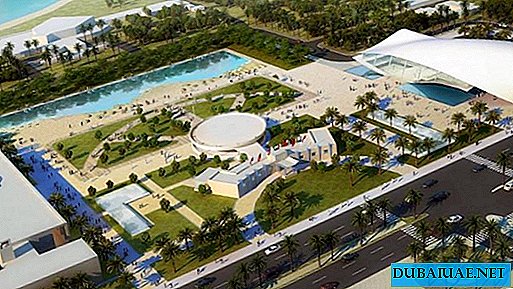Oases or islands? Where for the first time settled people who lived in the UAE thousands of years ago? And did they live in this area at all in that dark time for local archaeologists?
Scientists say that life in the local hot sand, even if it’s not “made a big head” in history, but danced around bonfires. It is hard to imagine that a civilization like Sumerian, Ancient Egyptian, or at least Nubian could grow on this poor soil. Civilization - could not. Too few benefits were offered by the land, scorched, waterless and barren. The warm sea was generous with gifts.
The very first settlements in the history of the emirate's territory were discovered on the island of Murauuah. In the area of this island land, surrounded by an archipelago of land rising above the water surface, the most ancient inhabitants of these places, sensitive dugongs, whose body structure is very similar to elephants, still live. Paleontologists have already proven that millions of years ago, on the current sandy Arabian Peninsula, nature was "paradise", and the forests where elephants lived rose to the sky.
Researchers know that the population of the Persian Gulf region still 4000 years ago hunted for clumsy, languidly moaning above the water with the breath of sea sirens. During excavations on one of the islands more remains of dugongs were found than bones of camels, antelopes and other animals. Evidence has also been found on Murauah Island that dugongs, called sirens or “sea brides,” were objects of interest to local hunters. It is believed that the descendants of the once elephants who lived here left to feed on underwater meadows when the local terrestrial flora began to falter. They adapted to new living conditions to this day, and if they lost in mass compared to their distant ancestors, they didn’t do much, although they outwardly changed radically, having lost their trunk, which had turned into a thick-lipped mouth, and limbs that had become fins and tail .
We left on the island of Murauah from Abu Dhabi at about seven in the morning. They turned away from the rays of the rising sun and moved westward. The initial part of the journey took place in the fog that enveloped the desert. The driver slipped a turn, stopped, turned on the emergency lights, and for a long time hesitated to move in foggy milk in the opposite direction, in order to return to the fork in reverse. Gradually the fog thinned, dissipated and rose, getting stuck first in the spherical crowns of palm trees, and then, cutting off the tops of the supports of high-voltage gears. Gradually the sun withered him. On the right, coastal side of the road, densely planted with bushes and palm trees, smoking tractors, rare trucks and builders' tents began to loom. Drainage is created along the road. Apparently, it floods in rare rainy periods.
With the participants of the international symposium "The situation and preservation of dugongs in the Persian Gulf, the Red Sea and the western part of the Indian Ocean," we go to the island, which is considered an exemplary marine reserve of the UAE. The meeting participants noted a lack of scientific information about the life of these fearful and defenseless animals and wished to get acquainted with their habitats. I had my own interest: to see the most ancient sites of people who lived in these places several millennia ago.
Located 120 km from the capital, the village of al-Marfa, from which it was to sail by water, met the serene smooth surface of the sea. "Martha" in Arabic means a marina. This place was once busy and busy. Now silence. No nomads, no anglers, no camel pens. There are even no fishing longboats. Enthralled the people of the city. Near the old, densely knocked down and not repaired for a long time pier, not a soul. Near the sea, several houses are scattered. There is a hotel. Desalination plant works, the high pipes of which carry steam into the sky. Offshore, round carcasses of oil storage tanks huddle to the ground. A small bay, well protected from the vagaries of the sea, sheltered several motor boats. On the shore, deserted, calm and very hot.
The village, in the area of which a few decades ago mainly the Rumeisi tribe settled, played an important role in the life of this region. The tribe controlled a group of coastal islands. There are many islands. The trip organizers named about a dozen. Most of them are grouped in one place, in the area of shallows, which can be called an underwater, gentle mountain with flat peaks rising above the surface of the sea. The seabed is covered with green meadows. There is a lot of living creatures in the grasses, and dugongs graze.
Dugongs are sea cows. They are fully adapted to life in water, but breathe air. The shy mammals of gray-brown color that gave birth to the legends of mermaids reach 2-4 meters in length and weigh up to 400 kg. These extremely herbivorous animals, which are distinguished by great appetite and eat about 30 kg of grass per day, are found in shallow waters and are in the UAE under the protection of two federal laws.
The largest population of dugongs is located in Australia and consists of almost 80 thousand heads. Their largest cluster outside Australia is located in the Persian Gulf and the Red Sea. The herd grazing near the eastern and western coasts of the Arabian Peninsula, which can conditionally be called "Arabian", totals about 7300 goals. 40 percent of this herd is concentrated in the waters of the UAE.
We are heading for the island of Al-Bazm, bypassing the "Murauuah" - the main purpose of the trip. The distance to the island is about 40 kilometers. The shore, and then the high desalination pipes, quickly disappear from view. Ahead amidst the blue of the sea, green spots appear. These are the shallows. Here the dugong pastures begin. We stop at a large red buoy three miles from the island. Whitened by the sun, it is clearly visible, but its desert appearance is absolutely not attractive. The desire to go ashore, to look for the local "Robinson", living here alone as the keeper of the reserve, does not awaken. The organizers of the trip to land on land, on which there is no trace of civilization or life, do not offer.
At the buoy begins the conservation area. “Please do not smoke,” jokes, and maybe our “captain” Yussef seriously says. The Australians and the French television group smoke, looking at the distance. Nobody wants to leave the green ripples of water for the sake of an uncomfortable hot coast. We look around, listen. The rustling moan of a mermaid appears in the rustle of water. Dugongs can be under water without air for up to 6 minutes. At the end of the oxygen supply, they should rise to the surface for a couple of seconds in order to quickly and sonically inhale a new portion of air. A quarter of an hour passes. Silence over the sea. Only splashing water on the side of the boats.
"Can we see the sirens?" - I ask Yousef standing near the helm. “Did you see them yourself?”
Yousef lives on Murauah. He came by boat from the island specially for us, knows these places very well and answers in the affirmative. “Of course, I saw. I’ve been set here to protect them, but it’s unlikely that having arrived in the area of their pastures with a large group on noisy boats, we will be able to catch them by surprise. These are very sensitive animals. You need to approach them carefully, with oars,” he says. “Look at the meadow. You can see the traces of feeding of sea cows. Take a swim, in the end. Let's hope that we are lucky near Murauuah,” Yusef continues without inspiring any optimism. A daughter sunburned in the sun, he puts on a mask, flippers and falls out overboard. We follow him. The shallow water reaches the neck. I don’t know if dugongs swim here. The water column is too small for their size. You can chop the belly with a sea urchin or burn your back in the sun.
Indeed, a lot of sea grass. She's not thick. Each bush grows separately. For giant dugongs, to nourish their fats, apparently, you need to crawl along the bottom without stopping collecting 7-10-centimeter shoots. Although, what else should they do. I personally imagined the sea meadows more abundant and populated.
The meadow disappointed not only me. But maybe underwater pastures in other places nearby are better. We are not invited there. Nature reserve.
Half an hour later they moved towards Murauuaha. In the "zone of robinsons" there is a small pier and one paved with paving stones, either a street, or a track with electric lights. It runs its own desalination plant. Knocking generator that produces electricity. Local boys go down to the water, pick up grass brought from the mainland for sheep from the boat. In the air-conditioned guest house, we drink coffee and strong, thick tea, almost “chifir”, sweetened to the state of compote. The whole company relaxed in coolness. The hosts offer an open all-terrain vehicle ride around the island, which is 13 km long and 5.5 km wide. Few agree to a 43-degree midday heat. We are going with the French. They specially came from Mauritius for pictures of local wildlife. I need ancient human sites and fresh impressions. We pass the signboard "It is strictly forbidden ...", on which only these words are preserved. What exactly is forbidden to do, ate rust. The bans, apparently, have lost their relevance, and maybe there is simply no one or nothing to prohibit.
We rush along a well-rolled, smooth, clay road along an absolutely unattractive sea coast littered with natural garbage. Thickets of mangrove trees stretch between the road and the sea. Yussef sharply slows down, shows in the cleft between the trees: "Gazelles!" In the shade under the tree are two light brown goats hiding from the heat and do not take their eyes off us. They are scared, alert, but they don’t want to run out of the shelter of branches, out of the relative coolness. The self-preservation instinct still prevailed, and they rushed deep into the island. Yussef decided to chase the gazelles and began to cut them off the coastal thickets along a path punched in the sand.
Here we stumbled upon the one whom instinct not only did not save, but failed. A huge turtle lay in the middle of the path with a black boulder. Apparently, she was looking for friable sand near the coast in order to lay eggs in the place from which she herself began her journey through the seas. But over the decades that have elapsed since she got out of an egg here, the earth has dried up and compacted, and much has changed in her native and hot maternity hospital. The turtle did not have time to see the first wheel in its life. It flew into her from behind. Rubber with the yoke of iron cargo turned out to be more powerful than its horn shell of almost a meter diameter. The Tortilla probably lies on the road for a long time. The carapace still shines, and the white skull, similar to a human one, has already been exposed, staring empty eyes into the sky. The picture is perceived as an addition to the sign "Strongly forbidden" ...
Despite the gazelles, the tortoise, small groups of white flamingos near the shore, on which white, green, and blue water sets in strips as you move away from it, it’s hard to imagine an organized, normal life on this scruffy island. There are many traces of modern civilization. She visited here, but did not stop, leaving her rusty traces in the form of skeletons of cars, falling apart sheds and especially unpleasant on the free nature of urban garbage.
The ancient traces of a person’s stay on the island look more attractive, although an uninitiated look simply will not pay attention to them, will not understand that before your eyes are monuments of a thousand years ago. Surprising safety of the remaining historical relics here. For several thousand years, the winds blew, the sand sank, there were rains, the seasons succeeded each other, the sun rose and the sun set, climatic conditions changed, people were born, people lived and died. Time has brought to nothing the fruits of their labors. No parking has been preserved. Ancient life, as is most often the case in archeology, is represented mainly by burial grounds. They are hundreds of meters from the coast. Maybe the sea has changed shores over the millennia. Or people carried the burial away from the water. From the ancient buildings only their foundations and parts of the walls, consisting of flat stones, have been preserved.
The English archaeologist Dr. Mark Beach, who has been working here for several years, says that the remains of buildings discovered on the island are burial mounds. They are small in size and built of slates in a conical style, in which the stones are stacked on top of one another with a slight overlap so that their layers come together in the upper part, bringing the walls into a dome. These buildings, created absolutely without using wood, through sandwich technology, when layers of stone and clay alternate, are about seven and a half thousand years old. Local and English scientists have been working on the island since 1992. They opened here a dozen man sites and are engaged in their study. According to 43-year-old Dr. Mark, most of the burials date back to the late Stone Age.
Pottery, flint tips of a spear and arrow were found at the excavation site. Even fragments of a black stone bracelet have been discovered, which indicate that the natives of these places had an interest in beauty and the opportunity to devote their time to it. Not breaking up with a straw hat during his hot work in the field, a researcher trying to speak a little Russian, kindly provided our magazine with pictures taken on the island. Photos are imaginative, giving the opportunity to imagine the life of the distant ancestors of local residents. But it is impossible to imagine what was now deserted, waterless and sunburned Murauuah in those gray times. How did he attract people? Maybe their safe parking was here. Maybe they were random "robinsons" lost in the sea and trying to establish their life tens of kilometers from the mainland, which was not so easy to reach at that time.
Now new attempts are being made to equip the island. In the tidal zone, excavators lowered the brushes of the buckets into the water. Yussef says they are digging a canal. Apparently, a new life will come here.
The island of Abu Dhabi, which housed the emirate capital, 50 years ago was hardly more attractive than Murauah. And what has become! The experience of the capital allows us to hope that the now abandoned regions of the country have a future, that it is not for nothing that the distant ancestors of the emirates settled here.
Victor Lebedev












